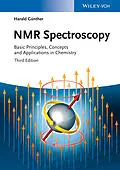Nuclear magnetic resonance (NMR) spectroscopy is one of the most powerful and widely used techniques in chemical research for investigating structures and dynamics of molecules. Advanced methods can even be utilized for structure determinations of biopolymers, for example proteins or nucleic acids. NMR is also used in medicine for magnetic resonance imaging (MRI). The method is based on spectral lines of different atomic nuclei that are excited when a strong magnetic field and a radiofrequency transmitter are applied. The method is very sensitive to the features of molecular structure because also the neighboring atoms influence the signals from individual nuclei and this is
important for determining the 3D-structure of molecules.
This new edition of the popular classic has a clear style and a highly practical, mostly non-mathematical approach. Many examples are taken from organic and organometallic chemistry, making this book an invaluable guide to undergraduate and graduate students of organic chemistry, biochemistry, spectroscopy or physical chemistry, and to researchers using this well-established and extremely important technique. Problems and solutions are included.
Autorentext
Harald Gunther studied Chemistry at the Universities of Stuttgart and Heidelberg, Germany, followed by a Postdoctoral Fellowship at Mellon
Institute, Pittsburgh, USA. He then became an assistant at the Institute of Organic Chemistry at the University of Cologne, Germany, where he also completed his habilitation. He became Professor of Organic Chemistry at the University of Cologne in 1970, and at the University of Siegen, Germany, in 1978.
Inhalt
Preface xv
1 Introduction 1
1.1 Literature 8
1.2 Units and Constants 9
References 10
Part I Basic Principles and Applications 11
2 The Physical Basis of the Nuclear Magnetic Resonance Experiment. Part I 13
2.1 The Quantum Mechanical Model for the Isolated Proton 13
2.2 Classical Description of the NMR Experiment 16
2.3 Experimental Verification of Quantized Angular Momentum and of the Resonance Equation 17
2.4 The NMR Experiment on Compact Matter and the Principle of the NMR Spectrometer 19
2.4.1 How to Measure an NMR Spectrum 19
2.5 Magnetic Properties of Nuclei beyond the Proton 25
References 27
3 The Proton Magnetic Resonance Spectra of Organic Molecules Chemical Shift and SpinSpin Coupling 29
3.1 The Chemical Shift 29
3.1.1 Chemical Shift Measurements 32
3.1.2 Integration of the Spectrum 35
3.1.3 Structural Dependence of the Resonance Frequency A General Survey 37
3.2 SpinSpin Coupling 41
3.2.1 Simple Rules for the Interpretation of Multiplet Structures 46
3.2.2 SpinSpin Coupling with Other Nuclei 49
3.2.2.1 Nuclei of Spin I = 1 2 49
3.2.2.2 Nuclei of Spin I > 1 2 51
3.2.3 Limits of the Simple Splitting Rules 52
3.2.3.1 The Notion of Magnetic Equivalence 52
3.2.3.2 Significance of the Ratio J/ 0 56
3.2.4 SpinSpin Decoupling 58
3.2.5 Two-Dimensional NMR the COSY Experiment 60
3.2.6 Structural Dependence of SpinSpin Coupling A General Survey 62
References 66
4 General Experimental Aspects of Nuclear Magnetic Resonance Spectroscopy 67
4.1 Sample Preparation and Sample Tubes 67
4.2 Internal and External Standards; Solvent Effects 70
4.3 Tuning the Spectrometer 74
4.4 Increasing the Sensitivity 78
4.5 Measurement of Spectra at Different Temperatures 81
References 83
Textbooks 83
Review Articles 83
5 Proton Chemical Shifts and SpinSpin Coupling Constants as Functions of Structure 85
5.1 Origin of Proton Chemical Shifts 86
5.1.1 Influence of the Electron Density at the Proton 87
5.1.2 Influence of the Electron Density at Neighboring Carbon Atoms 87
5.1.3 The Influence of Induced Magnetic Moments of Neighboring Atoms and Bonds 94
5.1.4 Ring Current Effect in Cyclic Conjugated -Systems 101
5.1.5 Alternative Methods to Measure Diatropicity 110
5.1.6 Diamagnetic Anisotropy of the Cyclopropane Ring 113
5.1.7 Electric Field Effect of Polar Groups and the van-der Waals Effect 114
5.1.8 Chemical Shifts through Hydrogen Bonding 117
5.1.9 Chemical Shifts of Protons in Organometallic Compounds 119
5.1.10 Solvent Effects 120
5.1.11 Empirical Substituent Constants 121
5.1.11.1 Tables of Proton Resonances in Organic Molecules 122
5.2 ProtonProton SpinSpin Coupling and Chemical Structure 122
5.2.1 The Geminal Coupling Constant (2 J) 123
5.2.1.1 Dependence on the Hybridization of the Methylene Carbon 123
5.2.1.2 Effect of Substituents 124
5.2.1.3 A Molecular Orbital Model for the Interpretation of Substituent Effects on 2 J 126
5.2.2 The Vicinal Coupling Constant (3 J) 128
5.2.2.1 Dependence on the Dihedral Angle 129
5.2.2.2 Dependence upon the CC Bond Length, R 130
5.2.2.3 Dependence on HCC Valence Angles 132
5.2.2.4 Substituent Effects 133
5.2.3 Long-Range Coupling Constants (4 J, 5 J) 137
5.2.3.1 Saturated Systems 138
5.2.3.2 Unsaturated Systems 139
5.2.4 Through-Space and Dipolar Coupling 143
5.2.5 Tables of SpinSpin Coupling Constants in Organic Molecules 144
References 147
Monograph 148
Review Articles 148
6 The Analysis of High-Resolution Nuclear Magnetic Resonance Spectra 149
6.1 Notation...
